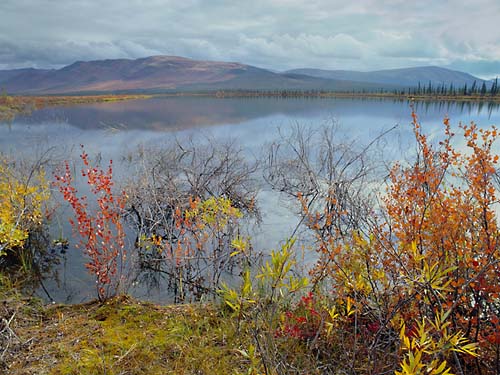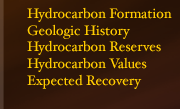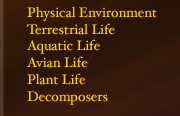
Environmental Implications - Plants
“Due to the
extreme cold, short growing season and nutrient-poor soils, Arctic
vegetation is extremely fragile. Plant communities scarred by bulldozer
tracks, oil spills and other human activities can take decades to
recover.”
Source: http://oz.plymouth.edu/~lts/conservation/Ecosystems/northslope.html
1.
Sedges and willows for nutrition
There are two major types of plants that are very important in
providing the herbivores (caribou, muskoxen, etc) with high quality and
nutritious food: tussock cottongrass (Eriophorum vaginatum) and
diamond-leaf willow (Salix planifolia ssp. pulchra). Surveys by US
Geological Survey have shown that disturbed areas by petroleum
development in other parts of Alaska exhibit significant decreasing
quantity and quality of these two plants. In disturbed areas, they have
lower biomass, lower nutritional values and higher fiber and lignin
concentrations which decrease digestibility. This in turn significantly
adversely affects reproduction and calving success of caribou that
highly depend on them.
(Janet C. Jorgenson, Mark S. Udevitz, and Nancy A. Felix, 2002)
2. Sedges
and willows for inhabitation
Willows in riparian areas are important nesting habitat for migratory
birds. Willows will be reduced in amount by heavy tracked vehicles for
seismic studies. They will also be affected in the long term by thawing
of permafrost, which would be discussed in greater details in the
latter part of this essay. Loss of nesting places means unsuccessful
calving for birds and higher chances of predation. Successful
rehabilitation techniques are yet to be developed for these areas.
(World Wide Fund for Nature, 2000)

Flame orange
dwarf birch and golden willow
Photo: Subhankar Banerjee
3.
Mosses and lichens for nutrition
While sedges and willows are important food source for herbivores
during summer, the growing and calving seasons, mosses and lichens are
more important for local herbivores during the bitter winter as they
can still grow well during the winter, though they have lower
nutritional values. Construction of drilling site, roads and tracked
vehicles all directly destroys the delicate mosses and lichens,
lowering the energy source for the herbivores such as muskoxen.
(Sarah J. Woodin & Mick Marquiss, 1997)
4. Mosses
and lichens for carbon and nutrient cycling
Mosses and lichens have a major influence on nutrient cycling in tundra
and other northern ecosystems through their role in nitrogen fixation,
and the ability of mosses to accumulate and retain elements from
precipitation. They restrict the draining away of nutrients and help
trap them during the summer and avail the nutrient for the herbivores
during the winter. Slow decomposition of mosses allows the mosses to
contribute significantly to the Arctic carbon sink. By photosynthesis,
they "fix" carbon from the atmosphere to organic compounds and by slow
decomposition they help trap the carbon instead quickly releasing them
back to the atmosphere. This helps soothing global warming. Destruction
means that all these functions cannot carry on.
(Sarah J. Woodin & Mick Marquiss, 1997)
5.
Mosses
and lichens for maintaining the permafrost
Mosses and their under-composed remains are particularly efficient in
thermal insulation when dry, thus restricting heat penetration into
arctic soils in summer. Thermocarst resulting from destruction of the
vegetation by the summer use of tracked vehicles during early stages of
arctic oil exploration demonstrated the importance of the moss layer in
maintaining permafrost. This caused extensive thawing of permafrost.
The importance of permafrost on arctic ecology will be discussed in the
next paragraphs.
(Sarah J. Woodin & Mick Marquiss, 1997)
Summary
“The effects of winter seismic trails on tundra vegetation were studied
on the Coastal Plain of the Arctic National Wildlife Refuge. Plant
cover was lower on most disturbed plots than on their adjacent
controls, with decreases as high as 87% the first summer following
disturbance. The species most sensitive to disturbance were evergreen
shrubs, followed by willows, tussock sedges, and lichens. Willow height
in riparian shrubland plots was significantly reduced by 5 to 11 cm
(from an average of 16 cm, p < 0.05). Little recovery of plants
occurred in the second or third summers after disturbance; only four
plots in river floodplain habitats (Dryas terrace and riparian
shrubland) showed improvements in cover of a few species.”
(Felix NA, Raynolds MK, 1989)
Reference:
1. Janet C. Jorgenson, Mark S. Udevitz, and Nancy A.
Felix, (2002). Arctic Refuge Coastal Plain Terrestrial Wildlife
Research Summaries, http://www.absc.usgs.gov/1002/section5.htm
2. World Wide Fund for Nature. (2000). Protection of
the Artic National Wildlife Refuge: Key to Managing one of the World's
Most Biologically Valuable Ecoregions, the Arctic Coastal Tundra, http://www.worldwildlife.org/arctic-refuge/anwr_position.pdf
3. Sarah J. Woodin & Mick Marquiss. (1997).
Ecology of Arctic Environment
4. Felix NA, Raynolds MK. (1989). Arctic and Alpine
Research, vol. 21, no. 2, pp.,
http://www.csa.com/hottopics/ern/01aug/01aug16.html





